Prologue
 Back on December 12, 2014, I posted my first ever camera review on this site, for the Argus C3 Match-Matic. The idea to write about an old camera was just something I thought up on a whim and put together that review with my thoughts, and some sample pics I got from that camera. Never in a million years, would I have imagined that nearly five years later, my site would have grown into what it was.Over the years, I’ve refreshed a few posts to bring them up to my current formatting standards, but with this review, I’m leaving that original post as it was when I first published it, and creating an all new article covering the entire Argus C-series. I hope you enjoy it.
Back on December 12, 2014, I posted my first ever camera review on this site, for the Argus C3 Match-Matic. The idea to write about an old camera was just something I thought up on a whim and put together that review with my thoughts, and some sample pics I got from that camera. Never in a million years, would I have imagined that nearly five years later, my site would have grown into what it was.Over the years, I’ve refreshed a few posts to bring them up to my current formatting standards, but with this review, I’m leaving that original post as it was when I first published it, and creating an all new article covering the entire Argus C-series. I hope you enjoy it.
As I began writing this article, I began to hit milestones I had never hit with any previous camera review. My typical review is between four to six thousand words with the largest topping out at eight thousand words. But this time, I shattered the ten thousand word barrier, and hit eleven, then twelve thousands. I couldn’t stop myself, I just kept typing.
After having some sense talked into me by fellow collectors and bloggers, I decided to split up this Argus piece into five separate articles for you to enjoy in smaller parts. This week, I will release one piece at a time, with a full version of the whole article on Friday. The five parts will be:
- I – History of Argus and the C-series
- II – Repairing Your Argus
- III – Identifying the Argus C-series
- IV – My Thoughts/Using a C3/Accessory Lenses
- V – My Results
I hope you enjoy reading everything just as much as I had writing it.
Introduction
This is the Argus C-series. First released in 1938 as the Argus Model C, the C-series includes the best selling American camera ever made, the Argus C3. Over 2.2 million were produced over the course of 28 years, the C-series saw many subtle variations and incremental improvements, but generally retained the same brick-like shape and pre-war feature set until the very last cameras came off the assembly line in 1966. The reason for it’s success was it’s unique looks, quality optics, capable feature set, and affordable price. The C-series had an interchangeable lens mount and had a variety of German made auxiliary lenses available for it. It was used by amateurs, professionals, students, the military, and countless other people in nearly every profession.
History
Of all the American companies who produced cameras in the 20th century, Argus was second only to Kodak in terms of sales and brand recognition. If you consider that despite their tremendous success, Kodak was a film first company, whereas Argus largely stayed within the camera making business, so you could say that Argus was the most successful American camera company of all time.

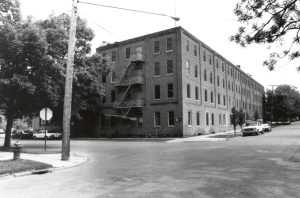
Based in Ann Arbor, MI, Argus was founded in 1931 as the International Radio Corporation by a group of 10 investors including Ann Arbor mayor, William Brown and businessman Charles Verschoor. The new company was located in the former headquarters of the Argus Furniture Company, located at 405 Fourth Street.
Back then, IRC made a variety of different radios, many of which had pioneering designs largely using Bakelite plastic, a relatively new material in the construction of radios and other electronic appliances. IRC’s products included the Kadette which was the first mass produced AC/DC radio. Bakelite was a very flexible product that could be made in a variety of colors, including a wood grain which gave it a look of a much more expensive radio. It sold extremely well and allowed IRC to release other Kadette products like the Kadette Jr, which was the world’s first pocket radio, and the Kadette Clockette which was one of the first clock radios.
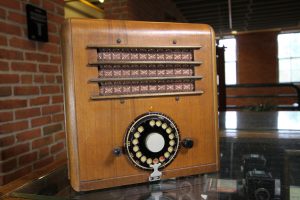
In the first half of the 1930s, IRC’s radio business was so successful in that it was the only company in Ann Arbor that was able to pay dividends to it’s share holders during the Great Depression. Nearby Detroit was heavily hit by the recession, so in the entire state of Michigan, IRC was one of the few financial bright spots.
By the mid 30s as the depression dragged on, other competing radio manufacturers were able to make inexpensive radios that ate into IRC’s profits, so the company needed to find a way to diversify it’s product offerings. On a trip to Germany, Charles Verschoor looked at a Leica camera and thought that with his expertise at making inexpensive items using Bakelite, that he could do for the camera industry, what he did for the radio industry.
IRC would release the Argus Model A camera in 1936 to immediate success. Like it’s radio division, the Argus Model A was an inexpensive Bakelite body camera that brought photography into a price range that didn’t have a lot of competition. The price of the Argus A then was $10 (some sites say $12.50) which meant it could be afforded by the average lower to middle class family.


The design for the Argus Model A is most often credited to a Belgian designer, professor, and engineer named Gustave Fassin. Fassin was a bit of a freelance of sorts in the 1930s as a part time professor and designer for Bausch & Lomb, Kodak, Argus, and perhaps other companies. I found no evidence that suggests he was a permanent employee of IRC, so perhaps he was paid as an independent contractor to come up with the design.
The Argus A was the very first American made camera to use Kodak’s new 135 format 35mm film cassette. Even though Kodak had already been selling the Kodak Retina for 2 years prior to the Model A’s introduction, the Retina was designed and built by Kodak AG Stuttgart, Kodak’s German subsidiary.
It sold very well, so well in fact, that IRC decided to stop radio production altogether and focus entirely on producing cameras. In 1938, due to the success of it’s cameras, IRC officially became known as the Argus Corporation and sold off it’s radio division to an entirely new company.
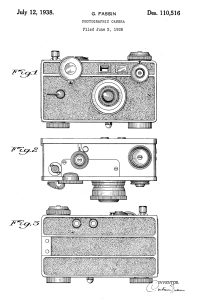
Sensing an even greater need to offer more competitive features in a camera at a low price point, later that year, Argus once again tapped Gustave Fassin for the design of their next camera. Fassin filed design patent 110,516 on June 2, 1938 for what would become the Argus C.
Although Fassin designed the camera, the shutter was built by Theodore M. Brueck, while working for the Ilex Optical Company of Rochester, New York. Patent 2,176,621 was filed with the US Patent Office under Brueck’s name assigned to Ilex on August 1, 1938 around the same time as the release of the Argus C. This patent clearly shows the front of an Argus C, but has no mention of the company or the Argus camera by name. Instead, the text within the patent mentions the need for a very shallow and compact shutter that can be attached to “a camera of the type to which my invention is applied”.
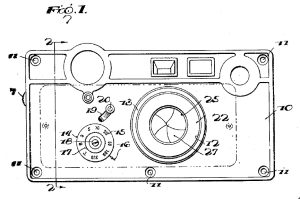
Although clearly showing an Argus front plate, there are some notable differences between the shutter showed in the patent and what actually appeared in the camera. For one, the shutter speed dial is located on the front plate of the camera, to the left of the lens mount, with speeds 1/2 – 1/300 plus B and T on a single dial. This of course is not how the shutter speed dial ever looked. There is some kind of sliding switch above the dial which the documentation describes as a “setting pin” but it’s function is not clear to me.
Another deviation between the drawing in the patent and the real Argus shutter is that the patent shutter has five blades whereas all Argus shutters I’ve ever seen have only three. The patent shutter also looks far more complex than any I’ve seen in an Argus suggesting this shutter isn’t at all the same as the one in the final camera. Since the patent was filed in the same year as the camera went on sale, perhaps the patent shutter was a proposed version for a later Argus camera, but never developed, or maybe even this shutter is not at all related to the ones found in the Argus C-series, and maybe Brueck just liked the Argus design and used their front plate design as a template for a completely unrelated shutter.
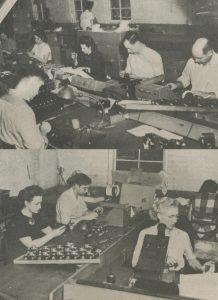
Is this a glimpse of a future Argus prototype or an early iteration of a shutter that was later simplified? We’ll likely never know the answer, or what role this patent shutter plays in the final version, but it’s a fun look at a possible alternate version of what might have been.
Argus’s new camera shared almost nothing with the earlier Model A. Featuring a distinct brick-shaped Bakelite body with polished metal front and back panels, an interchangeable lens mount, and an uncoupled split image rangefinder, the Argus C was quite a step up from the Model A.
Fun Fact: There actually was an Argus B produced in 1937, but it was just a variant of the Model A with a German Prontor II shutter and Argus 50mm f/2.9 lens. This model was produced for a very short time and only a couple hundred are thought to exist.
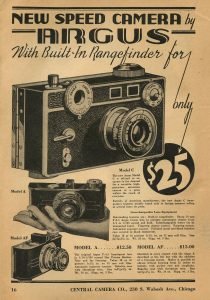
Perhaps the best feature of the Argus C was it’s price. Argus believed that the average American working family should be able afford a high quality and competent 35mm camera, so they priced the C at $25, which was the average weekly salary of a typical American family at the time. This price compares to $454 today which before taxes, adjusted for a 52 week year, compares to someone making $31,477 in 2019.
The Argus C saw several updates very soon after it’s release, the first being a redesign of the slow speed governor on the shutter. It was found that the original model’s “Fast/Slow” shutter was unreliable, and it was simplified to have a single shutter speed dial with speeds from 5 – 300 on it. Both Arguses with and without this hi/low speed switch are officially called the Argus C.
The next change was the addition of a coupling wheel in between the lens mount and the rangefinder wheel. Although a seemingly minor feature, it meant that adjustments to the focus distance on the lens automatically moved the rangefinder whereas prior, when a distance was measured on the uncoupled rangefinder, the photographer would have to separately rotate the lens. Models with the coupling wheel were called the Argus C2 and the price remained $25.
The third change was an upgrade to the shutter for flash synchronization and adding two small holes on the camera’s right side, which connect to a proprietary Argus flash gun. When using flashbulbs with this flash gun, the camera was synchronized at all speeds. Models with the flash synchronization were called the Argus C3.
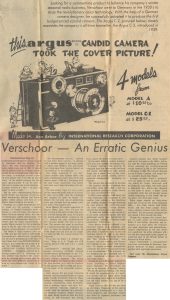
The C and C2 both debuted in 1938, with the C3 in early 1939. The original model was only offered one year, the C2 was produced through 1942, and the C3 was produced both before and after the war.
The new C-series was an immediate success and many were sold, but Argus was losing money as fast as they could make it. Company president, Charles Verschoor was a visionary businessman and keen salesman, but lacked financial prowess. A lack of proficient bookkeeping, overgenerous stock dividends, and elaborate corporate spending, caused the company to have a net loss, despite great sales. This resulted in Verschoor’s resignation from Argus in 1938.
Under new management led by businessman Robert D. Howse, Argus reinstated radio production and quickly turned to military contracts for the US war effort in Europe. In the early 1940s, Argus became profitable again producing binoculars, gun sights, radio power supplies, remote controls, and other products for the United States and it’s allies. They also increased capacity for the Argus C3 35mm rangefinder and started producing a medium format twin lens reflex camera called the Argoflex.

By 1942, business was very good for Argus, with profits up to $4.8 million from a net loss in 1938. After the war, Argus sought to remain dominant in it’s consumer camera divisions but planned to continue it’s work with American and foreign militaries, using it’s experience to continue to develop optical and radio products. This was rather unique in the optics industry as most companies who turned to military production during the war, ceased all government contracts afterwards, but not Argus.
Argus was so invested in the war effort, in 1945 they produced a propaganda video to showcase the company’s efforts in the American war effort. The video is shown below, and was digitized by the Ann Arbor District Library.
The aftermath of World War II caused a disruption in supply of cameras and other optical equipment from Germany which caused many American companies to take up the challenge of building all new models to compete for the American photographer’s buying dollar. Established companies like Kodak and ANSCO released new cameras in the late 1940s, as did some newcomers like Clarus and Vokar, but the Argus C3 remained a best seller.
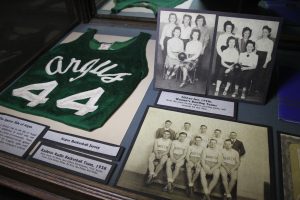
During the 1940s and 50s, working for Argus was a big deal. Thousands of employees from the Ann Arbor area worked for the company, receiving generous profit sharing incentives. The company had a newsletter called “Argus Eyes” that helped connect each employee with the direction of the company. Argus sponsored many athletic events, even having it’s own employee basketball and bowling teams. The company had elaborate Christmas parties and other social gatherings, often sharing news of marriages and child births in it’s company newsletter. It was a great honor to work for Argus during this time.
In January 1951, Modern Photography magazine ran a 7 page article on the Argus C3 which was generally positive, spending a lot of time on using the camera and it’s accessories. The article cautions you not to allow your finger to get in the way of the cocking lever when pressing the shutter release, and also gives some negative comments on the bulkiness of the camera’s case and the position of the aperture ring.
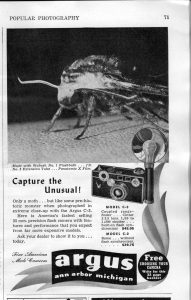
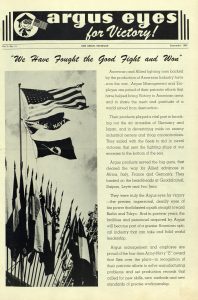
When camera production resumed after the war, the Argus C3 immediately went back on sale in late 1945. Initially, the very first post war cameras were identical to the pre-war versions, but by July 1946, cameras were produced with coated Cintar lenses and other minor cosmetic variations. The price had gone up too. The November 1949 issue of US Camera shows an ad for the C3 with case and flash unit for $78.08 after tax, quite a lot higher than the original $25 price tag of the first model. Of course the higher price wasn’t due to greed, rather inflation and a disruption of supplies were likely contributors.
The Argus C3 was tremendously successful in each year after the war through the end of the 1950s when sales started to decline. Although Argus never kept any detailed production numbers, we can reasonably estimate based on known serial number ranges that average annual sales during this time was somewhere around 150,000 cameras a year which is pretty incredible considering how long it was produced.
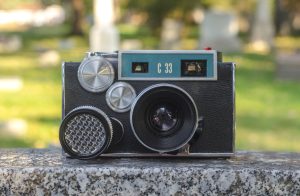
By 1958, Argus was struggling to stay profitable and was on the verge of bankruptcy. Although they had released a few other, more advanced cameras such as the C33 and C4 series, people kept buying C3s, and Argus wanted to freshen up the design to make the camera more relevant, so that year, they released two new models, one called the C3 Standard, and the other the C3 Match-Matic. Both cameras got a redesigned Cintar lens with a more attractive and larger barrel, an accessory shoe on the top plate of the camera, a new shutter release, and came with an Argus selenium exposure meter for the accessory shoe.
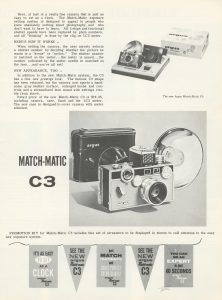
The Match-Matic came with a unique black and tan body covering, and simplified the exposure system by eliminating any reference to shutter speeds and f/stops, replacing them with numbers on the shutter dial and lens that you were to add together to get an EV (exposure value). The included meter indicated it’s light readings using these EV numbers, so if for example, the meter returned a reading of 12, any combination of numbers on the shutter dial and lens that added up to 12, would result in a properly exposed image.
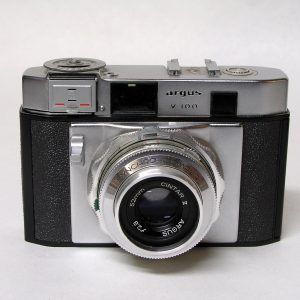
In 1959, Argus would be bought out by Sylvania Electric Products Inc who themselves had merged with General Telephone to form General Telephone and Electronics (GTE). Under new leadership Sylvania started to outsource production of new Argus cameras to other German and Japanese companies such as Certo, Iloca, Petri, and Mamiya. The Argus V-100 seen to the left was one such camera, which is just a rebadged Iloca Rapid IIL.
By the mid 1960s, the Argus Match-Matic and Standard were the only Argus cameras still manufactured in the United States, and in 1966, after a run of 28 years, production came to an end.
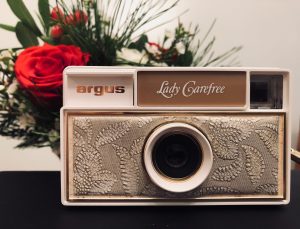
By the late 1960s, Argus would close up shop in Ann Arbor and relocate to South Carolina. The Argus name would continue to linger about for the next several decades as a badge applied to cheap Instamatic and pocket cameras. By the 2000s, it was even applied to some Chinese made digital cameras too, but nothing remotely that ever came close to the C3.

Today, the Argus C3 remains one of the most iconic cameras ever produced. Not only is it’s appearance unmistakable, but it is a popular prop used in motion pictures which portray photography in the early mid 20th century.
Argus C-series cameras are highly collectible, both intentionally, and unintentionally. Argus C3s often show up for prices so incredibly low, collectors who aren’t even interested in them somehow find them in their own collections. I have personally acquired a few in lots of other cameras where I wanted something else in the lot and the C3 just came along for the ride.
That doesn’t mean that they are not deserving of their place. The Argus C3 and it’s family played an extremely important role in the history of cameras, and one that is deserving of recognition. They’re harder to find in other areas of the world besides the United States, but if you get a chance to pick one up, I strongly recommend giving one a shot.
Please come back tomorrow for Part II – Repairing Your Argus.

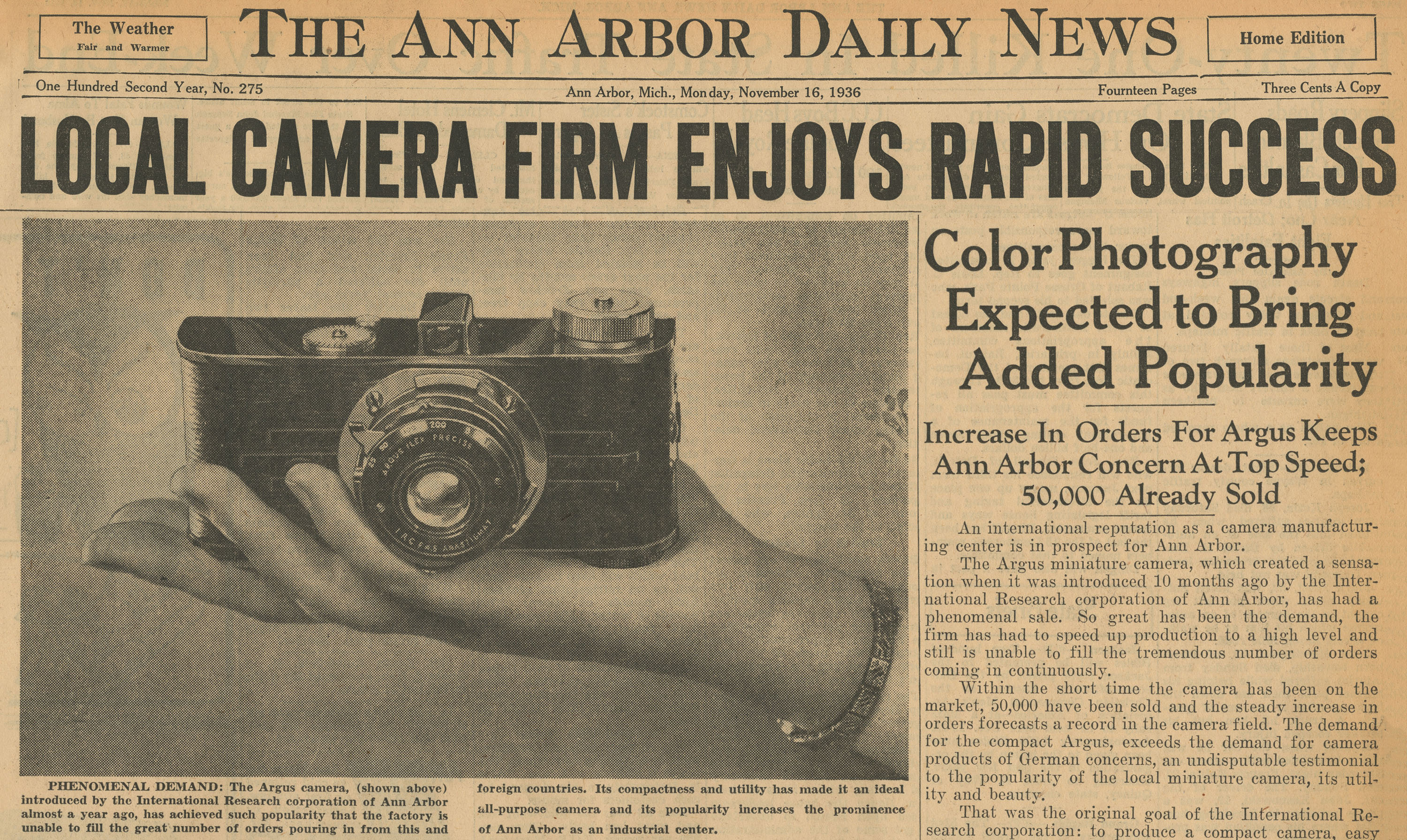
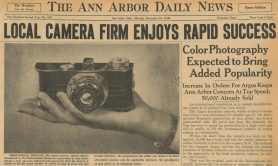
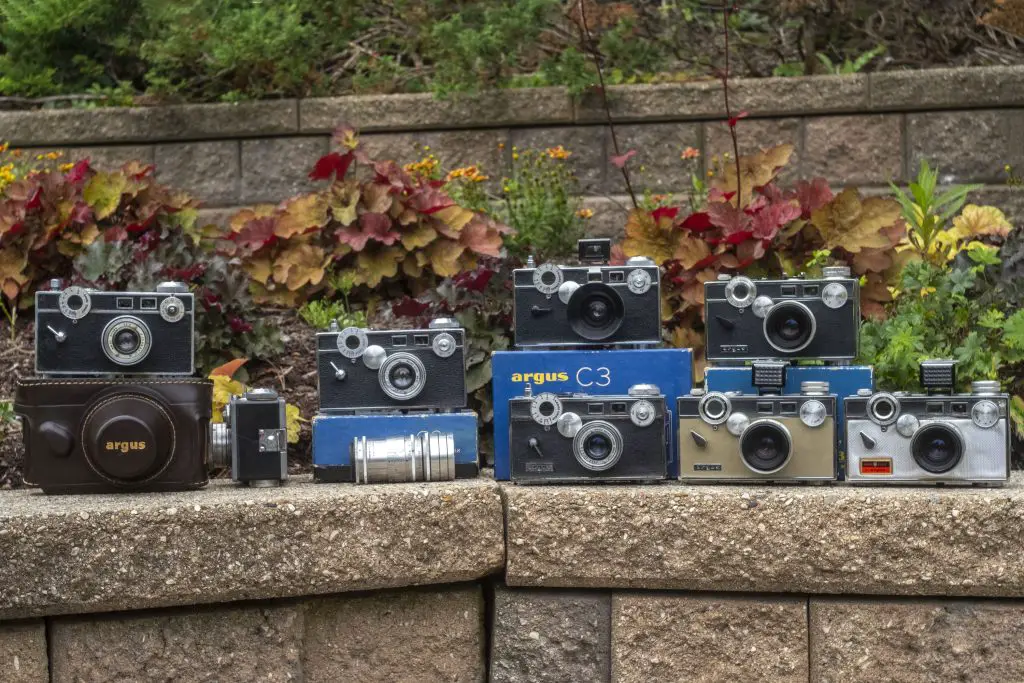
But where oh where is my beloved C20?